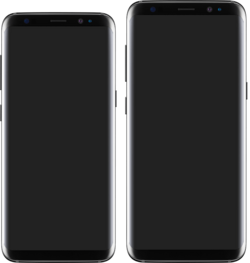 | |
 Samsung Galaxy S8 (left) and the S8+ (right) | |
| Brand | Samsung |
|---|---|
| Manufacturer | Samsung Electronics |
| Slogan | Unbox Your Phone |
| Series | Galaxy S |
| Model |
|
| Codename | Project Dream Cruiser (Galaxy S8 Active) |
| Compatible networks | 2G, 3G, 4G, LTE |
| First released | April 21, 2017 |
| Availability by region | April 21, 2017 April 28, 2017 April 29, 2017 May 5, 2017 May 12, 2017 May 18, 2017 May 25, 2017 June 8, 2017 |
| Discontinued | March 16, 2018 |
| Units sold | 41.067 million[1] |
| Predecessor | Samsung Galaxy S7/S7 Edge |
| Successor | Samsung Galaxy S9/S9+ |
| Related | Samsung Galaxy Note 8 Samsung Galaxy A8/A8+ (2018) |
| Type | Smartphone (S8) Phablet (S8+)[2] |
| Form factor | Slate |
| Dimensions | S8: 148.9 mm × 68.1 mm × 8.0 mm (5.86 in × 2.68 in × 0.31 in) S8+: 159.5 mm × 73.4 mm × 8.1 mm (6.28 in × 2.89 in × 0.32 in) |
| Weight |
|
| Operating system |
|
| System-on-chip |
|
| CPU |
|
| GPU |
|
| Memory | 4 or 6 GB LPDDR4X RAM |
| Storage | 64 GB UFS 2.1 / UFS 2.0 in some devices |
| Removable storage | microSDXC, expandable up to 256 GB |
| Battery | Non-removable
|
| Display | (both Diamond PenTile) |
| Sound | Sound and audio features e.g. speaker(s), audio jack, vibration motor, etc. |
| Rear camera | 12 MP (1.4 μm), f/1.7, OIS, 4K at 30 fps, 1440p at 30fps, 1080p at 60 fps, 720p at 30 fps, slow motion 720p at 240 fps |
| Front camera | 8 MP, autofocus, 1440p/1080p/720p video recording at 30fps |
| Connectivity | Physical and wireless e.g. USB type-C, Bluetooth 5.0 (LE up to 2 Mbit/s), 802.11 a/b/g/n/ac (2.4/5GHz) WiFi, NFC, location (GPS, Galileo, GLONASS, BeiDou) |
| Data inputs | |
| Water resistance | IP68, up to 1.5 m (4.9 ft) for 30 minutes |
| Other |
|
| Website | www |
| References | [5][6][7][8][9][10][11][12] |
The Samsung Galaxy S8 and Samsung Galaxy S8+ are Android smartphones produced by Samsung Electronics as the eighth generation of the Samsung Galaxy S series. The S8 and S8+ were unveiled on 29 March 2017 and directly succeeded the Samsung Galaxy S7 and S7 Edge, with a North American release on 21 April 2017 and international rollout throughout April and May. The Samsung Galaxy S8 Active was announced on 8 August 2017 and is exclusive to certain US cellular carriers.
The S8 and S8+ contain upgraded hardware and major design changes over the S7 line, including larger screens with a taller aspect ratio and curved sides on both the smaller and larger models, iris and face recognition, a new suite of virtual assistant features known as Bixby (along with a new dedicated physical button for launching the assistant), a shift from Micro-USB to USB-C charging, and Samsung DeX, a docking station accessory that allows the phones to be used with a desktop interface with keyboard and mouse input support. The S8 Active features tougher materials designed for protection against shock, shatter, water, and dust, with a metal frame and a tough texture for improved grip that makes the S8 Active have a rugged design. The Active's screen measures the same size as the standard S8 model but loses the curved edges in favour of a metal frame.
The S8 and S8+ received positive reviews. Their design, screen quality, and form factor received praise, while critics also liked the updated software and camera optimizations. They received criticism for duplicate software apps, lackluster Bixby features at launch, and for the placement of the fingerprint sensor on the rear next to the camera. A video published after the phones' release proved that the devices' facial and iris scanners can be fooled by suitable photographs of the user.
The S8 and S8+ were in high demand at release. During the pre-order period, a record one million units were booked in South Korea, and overall sales numbers were 30% higher than the Galaxy S7. However, subsequent reports in May announced sales of over five million units, a notably lower first-month sales number than previous Galaxy S series models.
On March 11, 2018, Samsung launched the successor to the S8, the Samsung Galaxy S9.
- ^ "Galaxy S9 sales are better than the Galaxy S8, but that's not saying much". bgr.com. 25 April 2018. Retrieved 8 January 2020.
- ^ "Samsung Galaxy Note 8 vs Galaxy S8 Plus: Phablet fight". 22 August 2017.
- ^ "Galaxy Note 8 & Galaxy S8 Don't Support Project Treble on Oreo". Gadget Hacks. 21 December 2017.
- ^ Cite error: The named reference
AndroidPieUpdatewas invoked but never defined (see the help page). - ^ Smith, Chris (24 May 2017). "The Galaxy S8 may be a huge hit, but Samsung is already working on the next big thing". BGR. Penske Media Corporation. Retrieved 18 July 2017.
- ^ Buckley, Sean (29 March 2017). "Samsung's 'unbox your phone' event gave us a phone that's still a box". Engadget. AOL. Retrieved 19 July 2017.
- ^ "Samsung Galaxy S8 Specifications". Samsung. Retrieved 30 March 2017.
- ^ Smith, Chris (29 March 2017). "Galaxy S8 and Galaxy S8+: The full specs". BGR. Penske Media Corporation. Retrieved 5 December 2017.
- ^ "Samsung Exynos 8895 Octa". NotebookCheck. Retrieved 5 December 2017.
- ^ "Qualcomm Snapdragon 835 (8998)". NotebookCheck. Retrieved 5 December 2017.
- ^ D., Luis (8 May 2017). "Lots of Snapdragon 835 Galaxy S8 units have UFS 2.0 instead of newer UFS 2.1 memory. Should you care?". PhoneArena. Retrieved 13 May 2017.
- ^ G, Mark. "Specifications – Samsung Galaxy S8 and S8+". Samsung. Retrieved 2 April 2019.